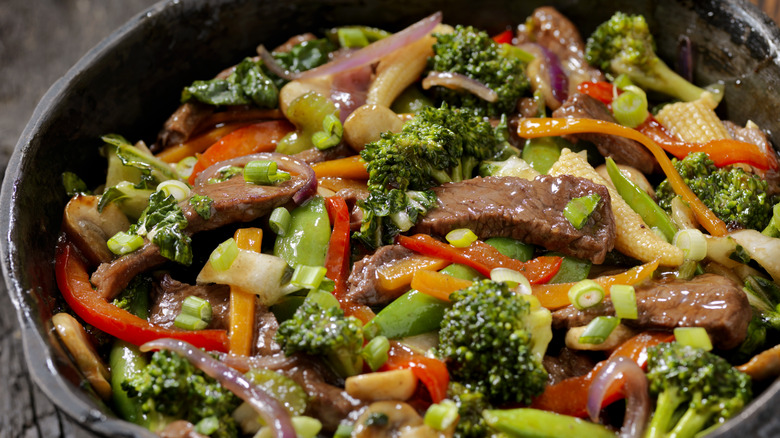Why You Should Consider Treating Your Meat As A Condiment
Whether from land, sky, or sea, many of us love to eat meat. According to Visual Capitalist, the total meat consumption in the United States is over 330 pounds (151.4kg) per capita per year, making it the fifth highest in the world. However, the population of the U.S. is over three and a half times the size of the other countries in the top 10, combined. In short, Americans eat a lot of meat.
There are significant reasons to eat meat: It provides essential nutrients unavailable in plants and can vitally support sustainable agriculture when done conscientiously. Plus, to many people, it simply tastes good, providing flavor and texture that humans are genetically wired to enjoy.
That said, there are also significant reasons to eat less meat. Other than documented environmental concerns, satiating our appetites with a lot of meat displaces adequate amounts of vegetables and grains from our meals. Eating a lot of meat is also expensive, costing up to $900 more in groceries per year than those consuming a plant-based diet.
So how do we balance dietary concerns, gustatory pleasures, environmental issues, and household budgets? The solution may be as simple as eating less meat overall. But then, how do we do that without feeling like we're depriving ourselves? Consider treating meat as a condiment; use it for flavor but not as the main star of the meal.
Combine, cut down, carve out
If the plate during meals often is segregated into clear chunks of "meat," "vegetables," and "starch," think about combining these components to take advantage of each other's flavors and textures. For example, instead of serving a large piece of chicken breast on top of a salad, try shredding the chicken beforehand and tossing it with the salad. In the literal sense, this is what is meant by "treating meat as a condiment:" It is possible that only half of said chicken breast needs to be used to distribute it evenly in the salad, and the eater will still enjoy both its flavor and texture.
How about reducing meat in soups and stews? This is arguably even easier to achieve. It does not take a lot of meat to flavor a stock, and is an age-old way of stretching a valuable ingredient to feed many people. Noted cookbook author Mark Bittman, who often advocates for eating less meat, points out how salt pork and bacon were used to season beans in American frontier cooking.
Cutting out meat entirely is not practical for many people and for many reasons. Yet another way forward is then to reallocate the proportions of food items on the plate. If meat regularly takes up half of the plate, reduce it over time until it only takes up a quarter of the plate. At the same time, increase the proportions of vegetables and grains accordingly so that the appetite remains sated.
Look globally for inspiration
For inspiration to eat with maximum flavor but less meat, look to cuisines around the world. Many cuisines traditionally place an emphasis on vegetables and grains over meat — East Asian cuisines are especially known for this, using meat sparingly to flavor vegetable dishes. When making recipes of beef and broccoli or mapo tofu at home, simply tweak the proportions to increase the vegetable content and reduce the meat.
For recipe ideas a little closer to home, try a quick collard greens with bacon, which can be substituted for salt pork or ham hocks for a more traditional flavor. Comfort food can also be tweaked accordingly. Because a lot of meat is not essential in making a flavorful soup, the bulk of a classic chicken noodle soup can be amped up with vegetables like carrots, peas, and corn.
At the heart of it, just remember that it is not about eliminating meat from the plate. It is about eating meat in mindful ways so that everyone wins: From consumers and their wallets, to the environment at large.


